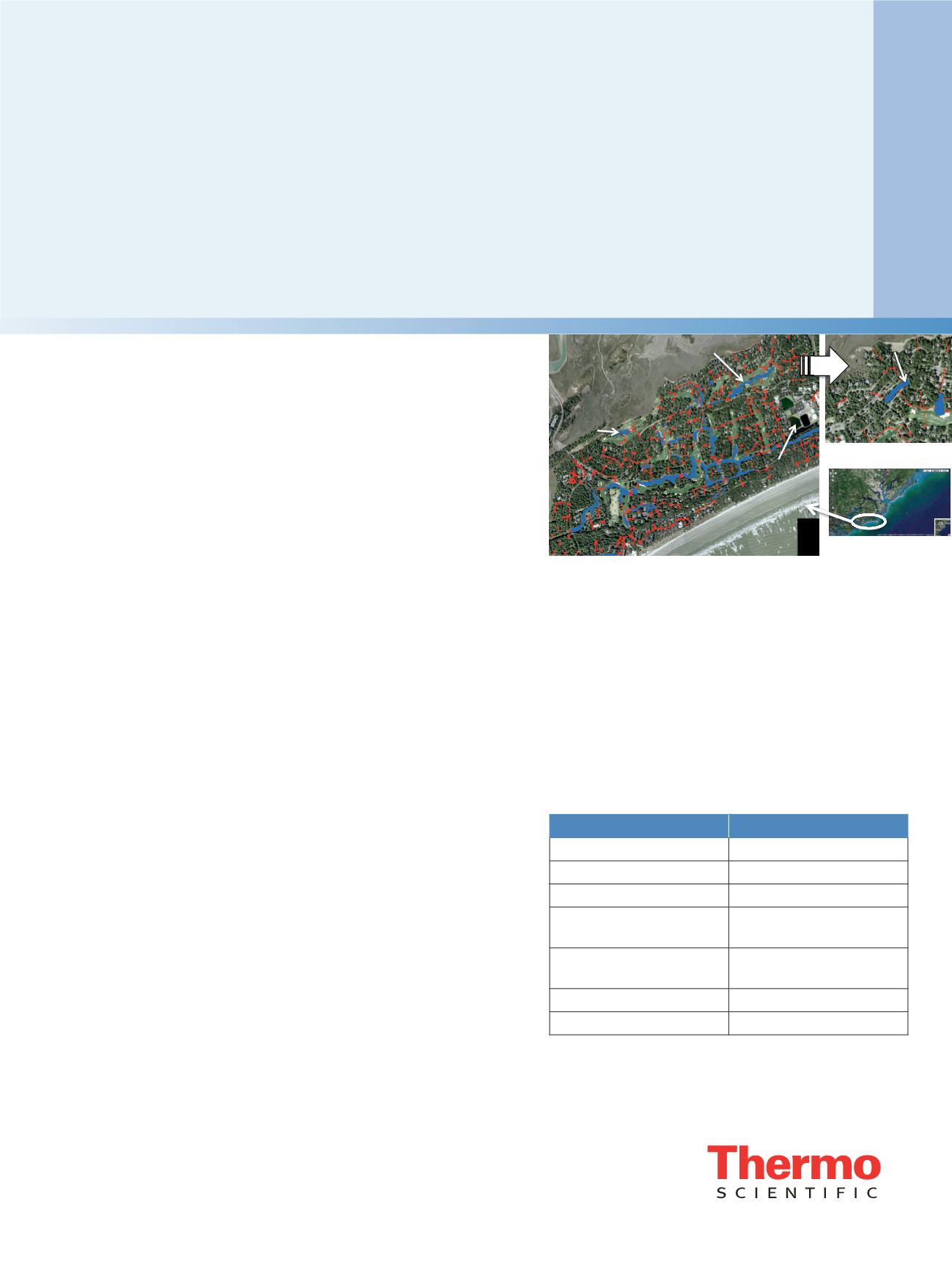

Kiawah Island, SC
Pond 25
Pond 5
WWTP Lagoon
Pond 43
Charleston, SC
Targeted and Nontargeted MS Analysis
of Contaminants in Storm Water
Retention Ponds
Gordon Getzinger
1
, P. Lee Ferguson
1
, Jonathan Beck
2
, Charles Yang
2
, Frans Schoutsen
3
1
Duke University, Durham, NC, USA
2
Thermo Fisher Scientific, San Jose, CA, USA
3
Thermo Fisher Scientific, Breda, The Netherlands
Application Note 599
Key Words
Environmental analysis, water analysis, wastewater, micropollutants,
EQuan MAX Plus, TSQ Quantiva, LTQ Orbitrap Velos
Goal
To demonstrate a data-driven environmental monitoring approach
for examining the occurrence and distribution of wastewater-derived
contaminants and turf-grass management organic compounds in storm
water retention ponds.
Introduction
Comprehensive assessment of the aquatic fate and effects
of organic micropollutants is greatly hindered by the need
to develop compound-specific methodologies prior to
sampling and analysis. A data-driven workflow, coupling
high-resolution, accurate-mass (HRAM) mass spectrometry
and highly sensitive online solid phase extraction (SPE)
analysis, ensures complete characterization of organic
pollutants in aquatic environments. In this work, water
samples collected from a coastal golf course community
were screened for the presence of trace organic
contaminants by a non-targeted HPLC–HRAM mass
spectrometry workflow. The occurrence of identified and
confirmed contaminants was then quantitatively assessed
by a high-throughput online SPE LC-MS/MS method.
Experimental
Sample Collection
Surface water, groundwater, and wastewater effluent
samples were collected from Kiawah Island, SC (Figure 1),
a coastal golf course community where turf-grass
management chemicals are extensively applied and
reclaimed wastewater is used for irrigation. Golf course
and storm water runoff are collected in ponds, which are
interconnected through a series of culverts and
communicate with the adjacent tidal estuary through
managed outfalls.
Initial sampling for non-targeted screening consisted of
0.5 L grab samples collected and field extracted by SPE
over two weeks in May 2010. Similarly, 10 mL grab
samples were collected in May 2011 for quantitative
analysis.
Sample sites were chosen to represent various routes of
micropollutant loading into the aquatic environment and
potential routes of chemical exposure as detailed in
Table 1. Golf course runoff consists of both turf-grass-
management chemicals applied to the course and
wastewater-derived contaminants introduced through
irrigation.
Table 1. Sample sites and descriptions of potential sources of
micropollutants to those site
Sample Site
Inputs
Pond 5
Golf course runoff
Pond 25
Golf course runoff
Pond 43
Residential storm water
Wastewater treatment plant
lagoon (WWTP)
Treated municipal wastewater
Wastewater composite (WW
Comp.)
24 hr composite effluent
Well 1
Infiltration from pond 25
Well 7
Infiltration from pond 5
Figure 1. Aerial view of Kiawah Island, SC. Water collection ponds,
shown in blue, are connected as indicated by the red lines.



















